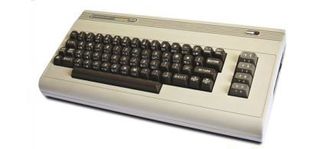Consoles of the '80s
Nintendo survives an industry crash and emerges as console king in day two of our historic coverage

Console: Commodore 64
Manufacturer: Commodore
Discontinued: 1994
The C64 entered the home PC market with 8-bits and a higher color resolution and better sound abilities than the Apple II and IBM PC - its direct competitors. Its success helped muscle Texas Instruments out of the PC market just in time for the industry crash. Even when the Master System and NES appeared on the scene quite a few years later, the C64 exhibited a healthy challenge. And nowadays, you can download some of the games on the Wii Virtual Console.

Console: Arcadia 2001
Manufacturer: Emmerson
Discontinued: Soon thereafter
Designed to wage war against the 2600, it was released just as the Atari 5200 and ColecoVision came out. The Arcadia 2001 was created to be portable, so if you were one of several people who owned a portable TV in 1982, then you were golden. It died quickly amongst its more recognizable and way more powerful competitors.

Console: ZX Spectrum - UK
Manufacturer: Sinclair
Discontinued: 1990
Aptly titled Spectrum (color graphics), the latest ZX model led to a boom in the UK videogame market and had a positive impact on the companies producing software for it. Many enthusiasts made illegal copies of games through tape duplication, leading to increasingly complex prevention techniques. The rubber keyboard was surprisingly comfortable. And it has a rainbow on it!


Console: Intellivision II
Manufacturer: Mattel Electronics
Discontinued: About the same year
A redesigned (and smaller) model of the Intellivision was ordered after the first installment started losing ground to the ColecoVision and the 5200. This version contained detachable controllers and a sleeker case. Because the Intellivision had way more games than the ColecoVision before 2600 compatibility, Mattel designed a “System Changer,” which was an adapter that played 2600 games.

Console: Adam Family Computer
Manufacturer: Coleco
Discontinued: 1985
This stunningly lousy system by Coleco elicited an electromagnetic charge upon boot-up, ultimately erasing any media left inside (e.g. games). With an exceptionally high price in 1983 ($725), poor sales and the fact that the computer came packaged with a magnet bomb, the system was kind of a failure andColeco filed for bankruptcy in 1988. They should’ve made more Pong systems.

Console: Aquarius
Manufacturer: Mattel Electronics
Discontinued: 1989
It’s a great sign that once the Aquarius was released, the Aquarius II was announced. Internally dubbed “the system of the 70s,” the Aquarius was a weak PC compared to the TI-99/4A and Commodore’s VIC-20. It used cassette tapes as a secondary storage unit and was on the tip of no one’s tongue.

Console: Apple IIe
Manufacturer: Apple
Discontinued: 1993
The ‘e’ stands for ‘enhanced.’ No, really. It does. The third model in Apple’s insanely popular II series and the longest-lived in computer in Apple’s history, the IIe added a full ASCII character set and keyboard. Also, the ever popular Delete and Tab keys were introduced. Low production costs coupled with an attractive feature set caused a number of these things to be snatched up at retail.
Sign up to the 12DOVE Newsletter
Weekly digests, tales from the communities you love, and more

Console: Nintendo Family Computer (Famicom) - Japan
Manufacturer: Nintendo
Discontinued: 1995
After a disastrous release including a product recall, the Famicom bounced back and became the best-selling console in Japan. This is mostly due to the success ofconsole-specific games like Super Mario Bros. and The Legend of Zelda (as opposed to the multi-platformPac-Man of times past) and to a new business model of software licensing agreements with third-party developers. Even greater success would be found in America’s launch of the system.
12DOVE was first founded in 1999, and since then has been dedicated to delivering video game-related news, reviews, previews, features, and more. Since late 2014, the website has been the online home of Total Film, SFX, Edge, and PLAY magazines, with comics site Newsarama joining the fold in 2020. Our aim as the global GamesRadar Staff team is to take you closer to the games, movies, TV shows, and comics that you love. We want to upgrade your downtime, and help you make the most of your time, money, and skills. We always aim to entertain, inform, and inspire through our mix of content - which includes news, reviews, features, tips, buying guides, and videos.
GTA 4 modders lose their YouTube channel as Take-Two seems to continue its quest to obliterate every GTA mod, but they still plan to deliver their upgraded Vice City
Gorgeous folklore action game South of Midnight reveals the best animal boss names since Elden Ring's Golden Hippopotamus and gets a spring release date
